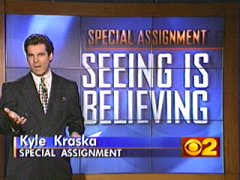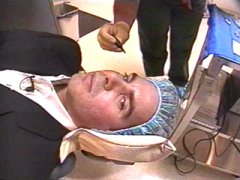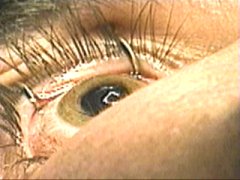 |
 |
 |
 |
| |
||||
Seeing is BelievingA CBS 2 News Special Assignment  Do you wear glasses or contacts? Do you wear glasses or contacts? Do you wish you didn't have to? Well, thanks to an innovative new surgery involving a laser, you might be able to regain perfect vision. CBS 2 News' Kyle Kraska went under the knife -- er, laser -- to explore this exciting new surgical procedure and lived to tell about it. Special Assignment: Seeing is Believing aired Wednesday, Nov. 12 at 11 p.m. Chances are you've heard of it, and you're very likely curious about it. But for the first time, CBS 2 News viewers got to see the latest in laser eye surgery -- every step of the way. "(LASIK is a procedure) where we use a machine to fold back the front layer of the eye," Dr. Caster told Kraska. "And then we apply laser energy to the surface of the eye and this causes the eye to change shape." Before surgery, a machine called an auto-refractor was used on Kraska to automatically determine his focusing ability. A prescription is read right off the machine and all Kraska had to do was stare down a long animated road. Astigmatism can also be corrected by the surgery. Finally, Kraska went through a routine but extensive eye exam. And after all the testing, it was determined that Kraska's eyesight was at about 20-1000 -- which meant that at even 20 feet away, his vision was pretty poor. Kraska was now set to undergo the LASIK procedure. An instrument called a microkeratome sliced the outer portion of his cornea, creating a flap. The flap was then gently rolled back to expose the inside of Kraska's cornea. This inside portion of the cornea is the area that the laser reshapes. An excimer laser is what treated Kraska's eye. This laser is so precise it can actually etch nicks into a human hair, said Kraska. The eye has an amazing ability to heal. In fact, the initial healing of his cornea took only a few hours. The entire procedure took less than 20 minutes. But best of all, said Kraska, he didn't feel any pain or sensation throughout the laser treatment. For more information on LASIK, take a look at the following resources:
|
|
 |
|
|
Retire Rich
 |

 |
||
|
12 p.m.
Woman 2 Woman One of the stars from "Judging Amy" 5 p.m. 6 p.m. 11 p.m.
|
||
 |
||
|
4-5 p.m.
Judge Judy Ruler Of The Free World! 8:00 p.m. 8:30 p.m.
9:00 p.m.
|
||
| |
||
 CBS 2 News' Kyle Kraska decided to meet Dr. Andrew Caster after reading his book, "The Eye Laser Miracle." Dr. Caster has not only performed hundreds of laser eye surgeries, but he has had undergone laser in-situ keratomileusis (LASIK) himself, said CBS 2 News' Kyle Kraska.
CBS 2 News' Kyle Kraska decided to meet Dr. Andrew Caster after reading his book, "The Eye Laser Miracle." Dr. Caster has not only performed hundreds of laser eye surgeries, but he has had undergone laser in-situ keratomileusis (LASIK) himself, said CBS 2 News' Kyle Kraska.  The next part of the exam involved a corneal topographer, said Kraska. The topographer was able to tell the doctor that Kraska had astigmatism in each eye -- meaning the cornea is oblong in shape.
The next part of the exam involved a corneal topographer, said Kraska. The topographer was able to tell the doctor that Kraska had astigmatism in each eye -- meaning the cornea is oblong in shape.  First, both eyes got a share of numbing drops. A patch was then placed over his left eye while his right eye was positioned under the laser; held wide open with a speculum, making it impossible for him to blink.
First, both eyes got a share of numbing drops. A patch was then placed over his left eye while his right eye was positioned under the laser; held wide open with a speculum, making it impossible for him to blink. 

